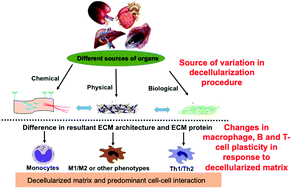当前位置:
X-MOL 学术
›
Biomater. Sci.
›
论文详情
Our official English website, www.x-mol.net, welcomes your feedback! (Note: you will need to create a separate account there.)
Regulation of decellularized matrix mediated immune response.
Biomaterials Science ( IF 6.6 ) Pub Date : 2020-01-13 , DOI: 10.1039/c9bm01780a Juhi Chakraborty 1 , Subhadeep Roy 1 , Sourabh Ghosh 1
Biomaterials Science ( IF 6.6 ) Pub Date : 2020-01-13 , DOI: 10.1039/c9bm01780a Juhi Chakraborty 1 , Subhadeep Roy 1 , Sourabh Ghosh 1
Affiliation

|
The substantially growing gap between suitable donors and patients waiting for new organ transplantation has compelled tissue engineers to look for suitable patient-specific alternatives. Lately, a decellularized extracellular matrix (dECM), obtained primarily from either discarded human tissues/organs or other species, has shown great promise in the constrained availability of high-quality donor tissues. In this review, we have addressed critical gaps and often-ignored aspects of understanding the innate and adaptive immune response to the dECM. Firstly, although most of the studies claim preservation of the ECM ultrastructure, almost all methods employed for decellularization would inevitably cause a certain degree of disruption to the ECM ultrastructure and modulation in secondary conformations, which may elicit a distinct immunogenic response. Secondly, it is still a major challenge to find ways to conserve the native biochemical, structural and biomechanical cues by making a judicious decision regarding the choice of decellularization agents/techniques. We have critically analyzed various decellularization protocols and tried to find answers on various aspects such as whether the secondary structural conformation of dECM proteins would be preserved after decellularization. Thirdly, to keep the dECM ultrastructure as close to the native ECM we have raised the question "How good is good enough?" Even residual cellular antigens or nucleic acid fragments may elicit antigenicity leading to a low-grade immune response. A combinative knowledge of macrophage plasticity in the decellularized tissue and limits of decellularization will help achieve the native ultrastructure. Lastly, we have shifted our focus on the scientific basis of the presently accepted criteria for decellularization, and the effect on immune response concerning the interaction between the decellularized extracellular matrix and macrophages with the subsequent influence of T-cell activation. Amalgamating suitable decellularization approaches, sufficient knowledge of macrophage plasticity and elucidation of molecular pathways together will help fabricate functional immune informed decellularized tissues in vitro that will have substantial implications for efficient clinical translation and prediction for in vivo reprogramming and tissue regeneration.
中文翻译:

去细胞基质调控的免疫反应。
合适的捐献者和等待新器官移植的患者之间的差距越来越大,这迫使组织工程师寻找合适的针对患者的替代方案。近来,主要从废弃的人类组织/器官或其他物种获得的脱细胞的细胞外基质(dECM)在高质量供体组织的有限可用性方面显示出巨大的希望。在这篇综述中,我们已经解决了理解dECM的先天性和适应性免疫反应的关键差距和经常被忽视的方面。首先,尽管大多数研究都声称保留了ECM超微结构,但几乎所有用于脱细胞的方法都不可避免地会导致ECM超微结构的破坏和二级构象的调节,这可能会引发独特的免疫原性应答。其次,通过对脱细胞剂/技术的选择做出明智的决定,找到保存天然生物化学,结构和生物力学线索的方法仍然是一个重大挑战。我们已经严格分析了各种脱细胞方案,并试图在各个方面找到答案,例如脱细胞后是否会保留dECM蛋白的二级结构构象。第三,为了使dECM超结构保持与原生ECM接近,我们提出了一个问题:“足够好?甚至残留的细胞抗原或核酸片段也可能引起抗原性,导致低级免疫反应。脱细胞组织中巨噬细胞可塑性和脱细胞极限的综合知识将有助于获得天然的超微结构。最后,我们将注意力转移到目前公认的脱细胞标准的科学基础上,以及对脱细胞细胞外基质与巨噬细胞之间相互作用的免疫应答的影响以及随后的T细胞活化的影响。合并合适的脱细胞方法,对巨噬细胞可塑性的充分了解以及分子途径的阐明,将有助于在体外制备功能性免疫已知的脱细胞组织,这将对有效的临床翻译以及体内重编程和组织再生的预测产生重大影响。以及对脱细胞细胞外基质与巨噬细胞之间相互作用的免疫反应的影响,以及随后的T细胞活化影响。合并合适的脱细胞方法,对巨噬细胞可塑性的充分了解以及分子途径的阐明,将有助于在体外制备功能性免疫已知的脱细胞组织,这将对有效的临床翻译以及体内重编程和组织再生的预测产生重大影响。以及有关脱细胞的细胞外基质与巨噬细胞之间相互作用的免疫反应的影响,以及随后的T细胞活化作用。合并合适的脱细胞方法,对巨噬细胞可塑性的充分了解以及分子途径的阐明,将有助于在体外制备功能性免疫已知的脱细胞组织,这将对有效的临床翻译以及体内重编程和组织再生的预测产生重大影响。
更新日期:2020-03-03
中文翻译:

去细胞基质调控的免疫反应。
合适的捐献者和等待新器官移植的患者之间的差距越来越大,这迫使组织工程师寻找合适的针对患者的替代方案。近来,主要从废弃的人类组织/器官或其他物种获得的脱细胞的细胞外基质(dECM)在高质量供体组织的有限可用性方面显示出巨大的希望。在这篇综述中,我们已经解决了理解dECM的先天性和适应性免疫反应的关键差距和经常被忽视的方面。首先,尽管大多数研究都声称保留了ECM超微结构,但几乎所有用于脱细胞的方法都不可避免地会导致ECM超微结构的破坏和二级构象的调节,这可能会引发独特的免疫原性应答。其次,通过对脱细胞剂/技术的选择做出明智的决定,找到保存天然生物化学,结构和生物力学线索的方法仍然是一个重大挑战。我们已经严格分析了各种脱细胞方案,并试图在各个方面找到答案,例如脱细胞后是否会保留dECM蛋白的二级结构构象。第三,为了使dECM超结构保持与原生ECM接近,我们提出了一个问题:“足够好?甚至残留的细胞抗原或核酸片段也可能引起抗原性,导致低级免疫反应。脱细胞组织中巨噬细胞可塑性和脱细胞极限的综合知识将有助于获得天然的超微结构。最后,我们将注意力转移到目前公认的脱细胞标准的科学基础上,以及对脱细胞细胞外基质与巨噬细胞之间相互作用的免疫应答的影响以及随后的T细胞活化的影响。合并合适的脱细胞方法,对巨噬细胞可塑性的充分了解以及分子途径的阐明,将有助于在体外制备功能性免疫已知的脱细胞组织,这将对有效的临床翻译以及体内重编程和组织再生的预测产生重大影响。以及对脱细胞细胞外基质与巨噬细胞之间相互作用的免疫反应的影响,以及随后的T细胞活化影响。合并合适的脱细胞方法,对巨噬细胞可塑性的充分了解以及分子途径的阐明,将有助于在体外制备功能性免疫已知的脱细胞组织,这将对有效的临床翻译以及体内重编程和组织再生的预测产生重大影响。以及有关脱细胞的细胞外基质与巨噬细胞之间相互作用的免疫反应的影响,以及随后的T细胞活化作用。合并合适的脱细胞方法,对巨噬细胞可塑性的充分了解以及分子途径的阐明,将有助于在体外制备功能性免疫已知的脱细胞组织,这将对有效的临床翻译以及体内重编程和组织再生的预测产生重大影响。



























 京公网安备 11010802027423号
京公网安备 11010802027423号